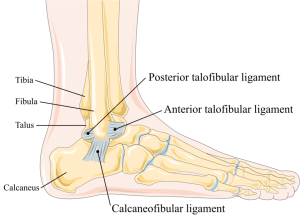Medically Reviewed by Dr. Paulina Piekarska
Key Takeaways
- A sprained ankle that still hurts after 2 weeks may be more severe than initially thought.
- Sprains do not show up on X-rays unless there is a gross disruption of ligaments or a gap between joints. X-rays give you limited insight into ankle sprains.
- Persistent pain after 6-8 weeks may warrant additional imaging like MRI or stress x-rays.
- Early evaluation and proper treatment can prevent long-term ankle problems.
All of us, at some time or another, have twisted an ankle, on uneven ground, or have come down awkwardly, while playing a sport, such as tennis or basketball. What often results is a painful ankle sprain, a tearing of the fibrous ligaments that stabilize our joints. Ankle sprains are some of the most common injuries seen in an orthopedic practice, with about 25,000 people, in the US, each day, seeking treatment for an ankle sprain.
This article is for active adults, athletes, or anyone recovering from an ankle injury who’s wondering why their sprain still hurts weeks later.
“My sprained ankle still hurts after 2 weeks – Why?”
Over 90% of ankle sprains involve an inversion, where the bottom of the foot turns inward, and the structures on the outer side of the ankle are put on stretch. Sprains are often graded from I to III, where a grade I sprain is a mild stretch injury, a grade II is a more significant partial ligament tear, and a grade III sprain is a complete rupture of one or more ligaments. Generally, there will be more bruising, swelling, and pain as the severity of the sprain increases.
When you visit your doctor after a sprain, they’ll likely order an x-ray to rule out a fracture. Patients are relieved when they hear that there is no fracture, however, even severe sprains are typically not visible on x-ray. It’s possible that a severely sprained ankle still hurts after 2 weeks, and may have a longer recovery and lead to more long-term problems than some simple fractures.
Julia, an avid runner and patient of OrthoConnecticut,, continued to feel ankle pain three weeks after a minor sprain. Turns out, she had an undiagnosed tendon injury that was visible on MRI. With a short course of physical therapy and a brace, she was back to running in 6 weeks.
Do Sprained Ankles Ever Fully Heal?
Regardless of the grade of sprain, most, if treated properly, will heal without residual pain or instability. The initial treatment involves the well-known mnemonic, RICE (Rest, Ice, Compression, and Elevation). Depending on the severity, the orthopedist may prescribe a brace, a walking boot, crutches, or physical therapy. Exercises to strengthen the surrounding muscles and tendons are essential to restore flexibility and stability.
How Long Does Ankle Pain Last After Sprain?
Additional studies, such as MRI or CT scan, are usually not necessary immediately after an ankle sprain, as the results of these expensive and time-consuming studies rarely affect the initial management of the sprain. We have found that a sprained ankle will commonly still hurt after 2 weeks, however, if pain persists for 6 to 8 weeks or more, and does not seem to be improving, these additional studies may be required to make a proper diagnosis.
One problem that may lead to long-term dysfunction and pain after an ankle sprain is instability. You might feel like your ankle is wobbly or keeps giving out, even if the ligaments aren’t torn. If laxity of the ligaments cannot be determined on the physical exam, the orthopedist may do a “stress x-ray”, where he or she manipulates the ankle while an x-ray is being taken. This is a quick and usually painless procedure that may give even more information than an MRI. Patients, who are found to be unstable, and remain functionally unstable, despite bracing and therapy, may be candidates for surgical reconstruction of their ligaments.
If the stress x-rays are normal, an MRI may be ordered to look for other sources of pain. These sources could include residual scar tissue from the sprain, subtle injuries to bone or cartilage, at the joint surface, as well as tears or instability of the tendons that surround the joint. If these issues remain symptomatic, despite conservative treatment, many can be treated with minimally invasive surgery using arthroscopy.
These arthroscopic procedures are usually done with local anesthesia and light sedation. Tiny incisions are made around the ankle through which narrow instruments and a fiberoptic camera can be inserted. The procedures take less than an hour, and patients return home the same day. Crutches are often required for only a week or two.
Seeking Treatment for Ankle Pain
Although many minor sprains are treated at home, without patients ever requiring medical attention, consultation with an orthopedic surgeon should be sought if there is significant bruising or swelling about the ankle, if there is pain and swelling above the ankle joint, or there is an inability to walk more than a few feet, without significant pain.
Patients with poor sensation in their feet, such as diabetics, have to be especially cautious so as not to overlook more serious injuries. Many long-term problems, after an ankle sprain, can be prevented if a prompt diagnosis is made and treatment is instituted soon after the injury.
If your sprained ankle still hurts after 2 weeks, don’t ignore it. Schedule an appointment with OrthoConnecticut’s foot and ankle specialists today to prevent long-term issues and get back on your feet.
FAQs
Is it normal for a sprained ankle to still hurt after 2 weeks?
Yes, especially with moderate to severe sprains. Healing can take several weeks, and some ligament damage will not show on x-rays.
When should I worry about my ankle pain?
If your ankle still hurts after 6–8 weeks, worsens, or causes instability, see a doctor. It could indicate ligament tears, tendon injuries, or joint damage.
What’s the recovery time for a sprained ankle?
Mild sprains: 1–2 weeks. Moderate: 3–6 weeks. Severe: 8+ weeks, sometimes requiring surgery or long-term rehab.
Can I walk on a sprained ankle after 2 weeks?
Possibly, but if walking causes sharp pain or limping, you may need further evaluation.
Will my ankle ever feel normal again?
With proper treatment and rehab, most people regain full strength and stability — but untreated injuries can lead to chronic problems.




















